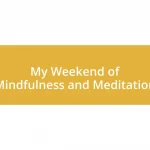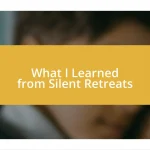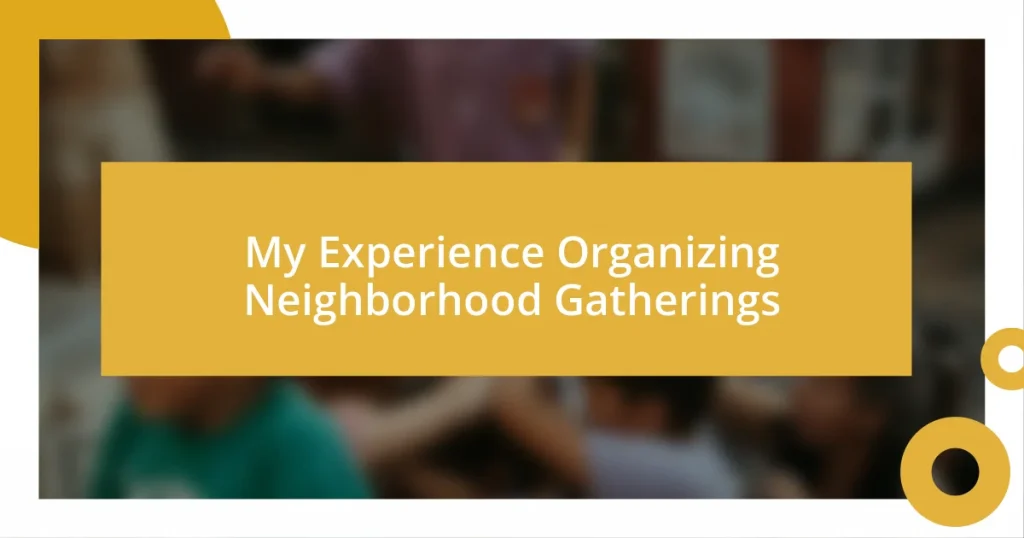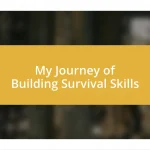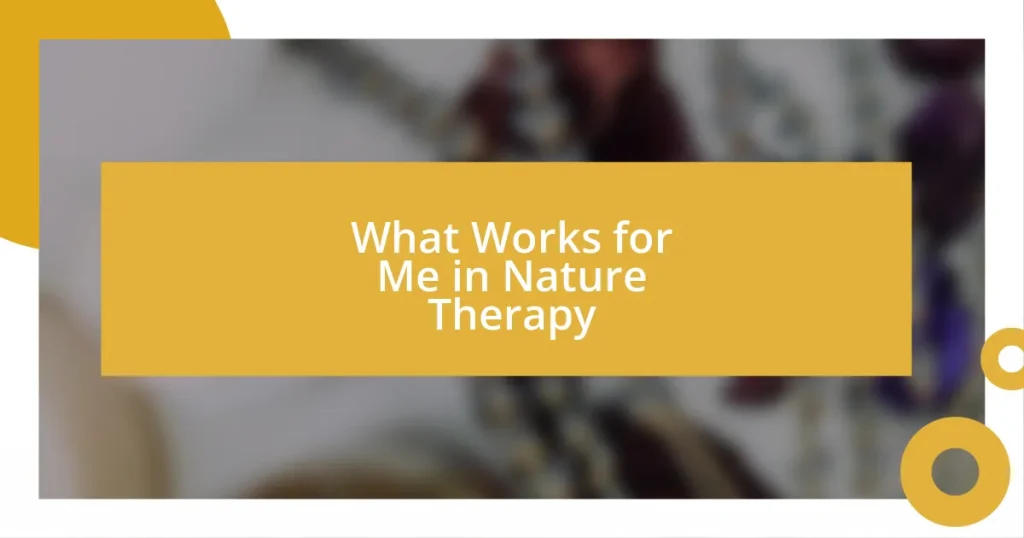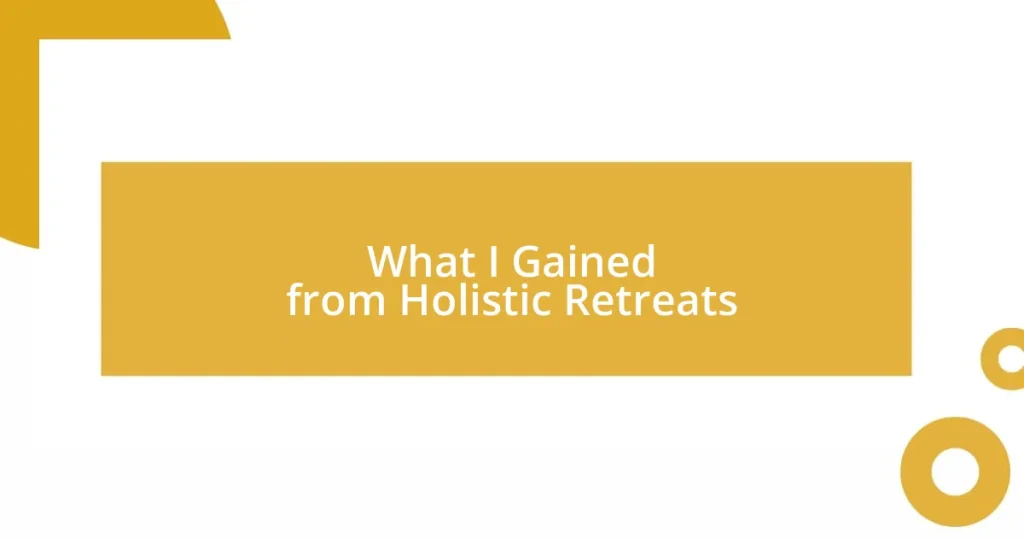Key takeaways:
- Neighborhood gatherings foster community connections, allowing residents to share experiences and support one another.
- Identifying community demographics, interests, and challenges is crucial for planning engaging and inclusive events.
- Evaluating gatherings through feedback and observing interactions helps improve future events and strengthens community bonds.
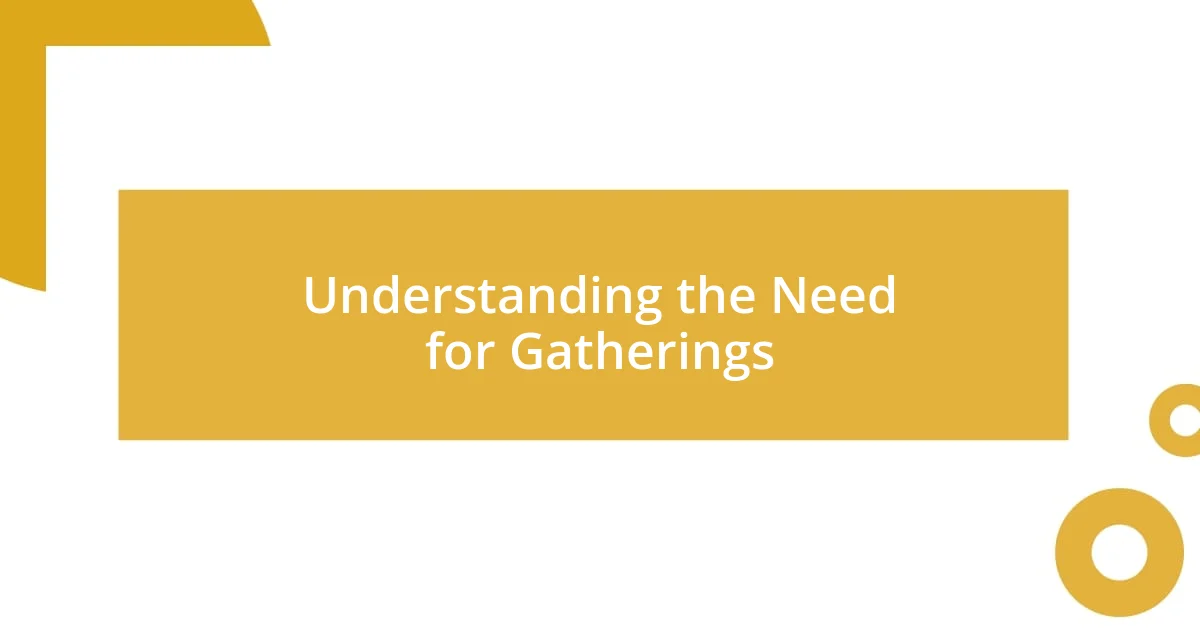
Understanding the Need for Gatherings
When I first moved to my neighborhood, I realized something essential was missing: a strong sense of community. It’s fascinating how just a few shared moments can transform strangers into familiar faces, making the streets feel a little less lonely. Why do we often overlook this basic human need for connection?
I still remember the warmth of laughter and conversations that flowed effortlessly during our first block party. It struck me that these gatherings serve as a vital bridge, linking our diverse backgrounds and experiences. Isn’t it amazing how gathering over food and games can ignite friendships that last?
In my experience, gatherings also offer a safe space for sharing concerns and aspirations. Whether it’s discussing local issues or celebrating successes, these moments help foster empathy and solidarity among neighbors. How often do we take time to listen and learn from one another? I’ve found that through these interactions, we grow not just as individuals but as a community.
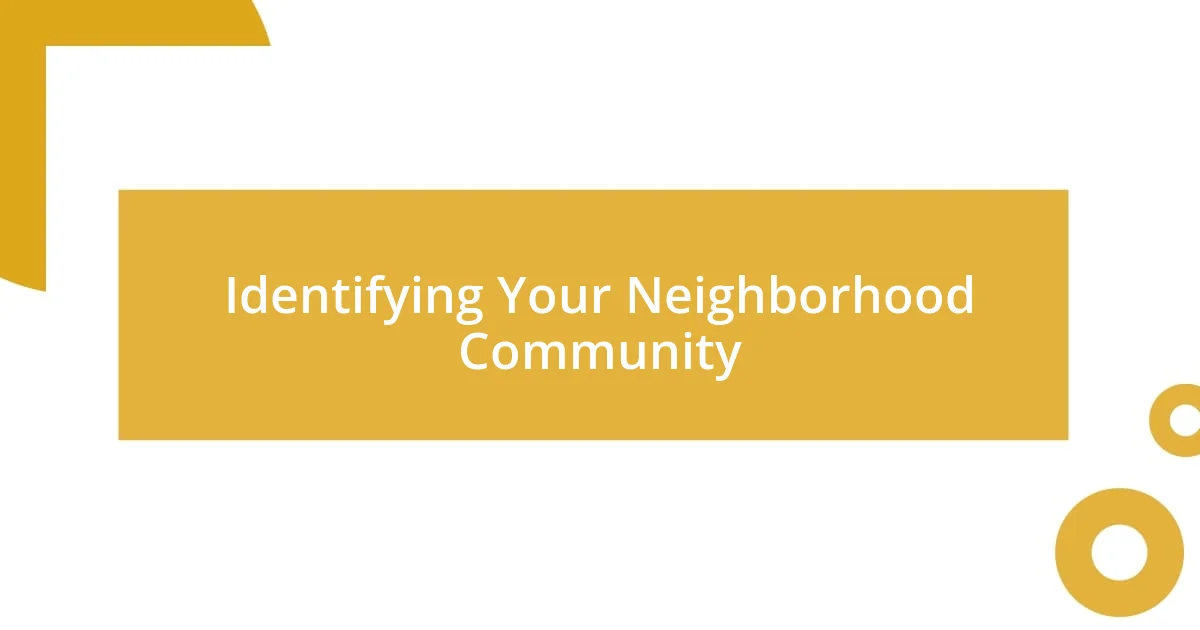
Identifying Your Neighborhood Community
Identifying the characteristics of your neighborhood community is a crucial step towards successful gatherings. For me, it was about truly observing who lived around me. The small interactions while walking the dog or chatting over garden fences gradually revealed different personalities, skills, and interests I hadn’t expected.
- Demographics: Understand the mix of ages, backgrounds, and cultures.
- Common Interests: Notice shared hobbies or activities that can serve as a conversation starter.
- Challenges: Pay attention to common concerns, like safety or local resources, that could bring neighbors together.
- Local Spaces: Identify communal areas like parks or community centers that encourage socialization.
- Communication Channels: Learn how neighbors share information—whether through online groups or newsletters.
In my neighborhood, I discovered an unexpected artist among the retirees and a budding chef next door, which opened avenues for creative collaborations. Just a friendly nod or a simple “hello” can lead to unearthing shared passions that add richness to community life.

Setting Goals for the Gatherings
Setting clear goals for neighborhood gatherings is vital for ensuring that they are both enjoyable and meaningful. I’ve found that pinpointing specific objectives helps in planning the event. For instance, do you want to strengthen social ties or tackle a community issue? By establishing these goals, I’ve been able to tailor activities to serve our collective aspirations, which makes every gathering resonate more deeply with participants.
Another goal I often embrace is inclusivity. I remember one gathering where we designed a potluck, inviting everyone to bring a dish that represented their culture. This not only led to a delicious spread but also fostered conversations about traditions and personal stories that might have otherwise gone unheard. It’s fascinating how a simple meal can encapsulate such rich experiences and bring people together in unexpected ways.
Furthermore, I believe it’s essential to evaluate the success of each gathering against the goals we set. After our last event, I distributed a quick survey to gather feedback. I wanted to know if our focus on inclusivity had been effective and if newcomers felt welcomed. The insights I gained were invaluable, providing me with a clearer perspective on what worked and what needed improvement for our next gathering.
| Goals | Actions |
|---|---|
| Strengthening Social Ties | Organize icebreaker games |
| Encouraging Inclusivity | Host a cultural potluck |
| Addressing Community Issues | Schedule discussions or workshops |
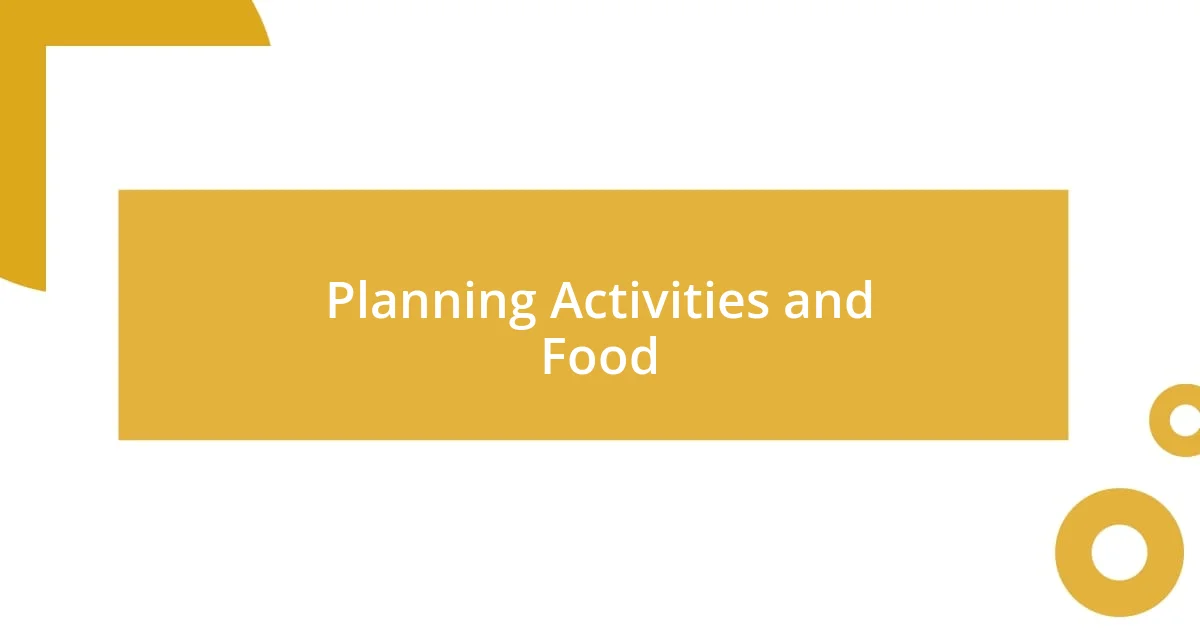
Planning Activities and Food
When it comes to planning activities and food for neighborhood gatherings, the goal is to create an inviting and enjoyable atmosphere. One of my favorite activities has been organizing a family-friendly scavenger hunt in the local park. It’s amazing how much fun adults can have alongside their kids, uncovering hidden treasures while bonding with neighbors. I remember seeing everyone’s faces light up as they found quirky items, igniting laughter and friendly competition.
Food plays a central role in these gatherings, often serving as the glue that brings people together. After hosting a few potluck dinners, I’ve learned that discussing dishes can spark deeper connections than you would expect. For example, when someone brought their grandmother’s famous lasagna, it became a conversation starter for stories about family traditions and cultural heritage. Have you ever experienced how a single dish can unravel so many valuable tales? It’s moments like these that transform a simple meal into a celebration of our diverse backgrounds.
I’ve also discovered that preparing a mix of food options, including vegetarian and gluten-free dishes, is crucial to ensure everyone feels included. At one event, a neighbor mentioned the importance of accommodating dietary restrictions, and I took that to heart. I started collecting a list of dietary preferences before the gathering, which allowed everyone to enjoy a variety of flavors without worry. This not only shows that we care but also enhances the overall experience by featuring everyone’s tastes, creating a delightful culinary journey.

Selecting a Date and Venue
Selecting the right date and venue for a neighborhood gathering sets the entire tone for the event. I’ve often found that weekends are typically the best option, as people feel less rushed and more inclined to join in. However, it’s essential to poll neighbors and choose a date that accommodates most schedules, perhaps even using a simple online survey to gauge availability. When I did this for my last gathering, we were pleasantly surprised by how quickly everyone responded, showcasing their excitement to participate.
The venue choice is just as critical as the date. For me, I prefer locations that feel familiar and welcoming—like a community park or a shared space at the local community center. I remember one gathering where we opted for a neighbor’s spacious backyard, and it transformed the atmosphere. We decorated it with fairy lights, which instantly made the place feel magical as the sun set. The intimate setting encouraged conversation and laughter, creating memories that linger long after the gathering ended. Have you ever noticed how the right environment can spark deeper connections among neighbors?
While selecting both the date and venue, consider accessibility to ensure everyone can show up. I often think about those who might have mobility issues or families with young children. Choosing a venue with ample parking and easy access can make all the difference. During one of our gatherings, a neighbor shared how grateful they were for the thoughtfulness of the venue choice, allowing them to join comfortably and enjoy the day with their kids. It’s moments like these that remind me how small considerations can lead to a larger sense of community.

Promoting the Gathering Effectively
Word of mouth can be a powerful tool when it comes to promoting neighborhood gatherings. I remember the excitement that bubbled up in my community when I simply mentioned our upcoming event during a casual chat at the mailbox. That little exchange led to more neighbors asking questions, and before I knew it, a buzz was spreading. Don’t underestimate the impact of personal connections; often, people feel more inclined to join if they hear about it from someone they know.
In addition to conversations, I found that using flyers is still an effective way to grab attention. I created colorful, eye-catching brochures and placed them strategically around our neighborhood—like on community boards and local cafés. The response was heartwarming; people told me they loved the design and the clear details about what to expect. Have you ever had that experience where a simple flyer made you feel a part of something special? It truly creates anticipation and excitement.
Social media is an invaluable resource for today’s gatherings. I took the plunge and created a dedicated event page to keep everyone informed and engaged. Sharing updates, sneak peeks of activities, and even polls for preferred snacks helped to create a sense of ownership among the neighbors. The moment I posted a countdown, the comments section lit up with enthusiasm! I realized how digital connections could enhance our community spirit. Isn’t it fascinating how technology allows us to bridge distances and cultivate relationships right from our phones?

Evaluating the Success of Gatherings
To evaluate the success of a gathering, I often reflect on the overall vibe and participation levels. After our last gathering, I noticed how engaged everyone was during the discussions, which was a promising sign of success—people were genuinely interested in connecting. Have you ever left an event wondering if anyone really enjoyed it? I felt reassured when neighbors approached me afterward, sharing stories and expressing their joy about the day.
Another crucial aspect I consider is the feedback I collect afterward. I’ve learned to ask for input both casually—like when we bump into each other at the local park—and more formally through a brief follow-up survey. During one event, I received a suggestion to include games for the kids, which made a lasting impact. It dawned on me that actively seeking opinions fosters a sense of belonging—people start to feel that their input truly matters, enhancing future gatherings.
Lastly, I pay attention to the connections made during the event. During one gathering, I spotted two neighbors bonding over a shared love of gardening. Watching them exchange tips and laughing together was a clear indicator of success for me. Isn’t it fulfilling to see relationships blossom in our community? Those moments reaffirm that I’m not just organizing events; I’m nurturing an environment where friendships can thrive.

